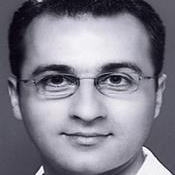International Journal of Information Engineering and Electronic Business (IJIEEB)
IJIEEB Vol. 6, No. 2, 8 Apr. 2014
Cover page and Table of Contents: PDF (size: 1737KB)
Computational Intelligence in Magnetic Resonance Imaging of the Human Brain: The Classic-Curvature and the Intensity-Curvature Functional in a Tumor Case Study
Full Text (PDF, 1737KB), PP.1-8
Views: 0 Downloads: 0
Author(s)
Index Terms
Classic-Curvature, Computational Intelligence, Intensity-Curvature Functional, Magnetic Resonance Imaging (MRI), Model Polynomial Function, Second-Order Derivative, Second-Order Differentiability
Abstract
This research solves the computational intelligence problem of devising two mathematical engineering tools called Classic-Curvature and Intensity-Curvature Functional. It is possible to calculate the two mathematical engineering tools from any model polynomial function which embeds the property of second-order differentiability. This work presents results obtained with bivariate and trivariate cubic Lagrange polynomials. The use of the Classic-Curvature and the Intensity-Curvature Functional can add complementary information in medical imaging, specifically in Magnetic Resonance Imaging (MRI) of the human brain.
Cite This Paper
Carlo Ciulla, Dijana Capeska Bogatinoska, Filip A. Risteski, Dimitar Veljanovski, "Computational Intelligence in Magnetic Resonance Imaging of the Human Brain: The Classic-Curvature and the Intensity-Curvature Functional in a Tumor Case Study", International Journal of Information Engineering and Electronic Business(IJIEEB), vol.6, no.2, pp.1-8, 2014. DOI:10.5815/ijieeb.2014.02.01
Reference
[1]I. Newton, and C. Huygens, “The motion of the moon’s nodes,” in R. M. Aynard Hutchins (Ed.), Mathematical Principles of Natural Philosophy: Optics, Treatise on light (A. Motte, Trans.), William Benton, pp. 338-339, 1934.
[2]C. De Boor, A practical guide to splines, Applied mathematical sciences, Springer-Verlag, 1978.
[3]M. Unser, A. Aldroubi, and M. Eden, “B-spline signal processing: Part I – theory,” IEEE Transactions on Signal Processing, vol. 41, no. 2, pp. 821-833, 1993a.
[4]M. Unser, A. Aldroubi, and M. Eden, “B-spline signal processing: Part II – efficient design and applications,” IEEE Transactions on Signal Processing, vol. 41, no. 2, pp. 834-848, 1993b.
[5]C. Ciulla, “Improved signal and image interpolation in biomedical applications: The case of magnetic resonance imaging (MRI),” Medical Information Science Reference, IGI Global Publisher, Hershey, PA, 2009.
[6]C. Ciulla, “Signal resilient to interpolation: An exploration on the approximation properties of the mathematical functions,” CreateSpace Publisher, 2012.
[7]C. Ciulla, and F. P. Deek, “On the approximate nature of the bivariate linear interpolation function: A novel scheme based on intensity-curvature,” ICGST - International Journal on Graphics, Vision and Image Processing, vol. 5 no. 7, pp. 9-19, 2005.
[8]C. Ciulla, “The intensity-curvature functional of the trivariate cubic Lagrange interpolation formula”, International Journal of Image, Graphics and Signal Processing, vol. 5, no. 10, pp. 36-44, 2013.
[9]S.K. Lele, “Compact difference schemes with spectral-like resolution,” Journal of Computational Physics, vol. 103, pp. 16-42, 1992.
[10]H. Farid, and E.P. Simoncelli, “Differentiation of discrete multidimensional signals,” IEEE Transactions on Image Processing, vol. 13, no. 4, pp. 496-508, 2004.
[11]J. Prewitt, “Object enhancement and extraction,” in: Picture Processing and Psychopictorics B. Lipkin and A Rosenfeld Eds., New York, Academic, pp. 75-149, 1970.
[12]Y. Cha, and S. Kim, “The error-amended sharp edge (EASE) scheme for image zooming,” IEEE Transactions on Image Processing, vol. 16, no. 6, pp. 1496-1505, 2007.
[13]K. Zarour, and N. Zarour, “Data center strategy to increase medical information sharing in hospital information systems”, International Journal of Information Engineering and Electronic Business, vol. 5, no. 1, pp. 33-39, 2013.
[14]A. K. Keshri, A. Singh, B. N. Das, and R. K. Sinha, “LDASpike for recognizing epileptic spikes in EEG”, International Journal of Information Engineering and Electronic Business, vol. 5, no. 4, pp. 41-50, 2013.
[15]A. Goshvarpour, H. Ebrahimnezhad, and A. Goshvarpour, “Classification of epileptic EEG signals using time-delay neural networks and probabilistic neural networks”, International Journal of Information Engineering and Electronic Business, vol. 5, no. 1, pp. 59-67, 2013.



